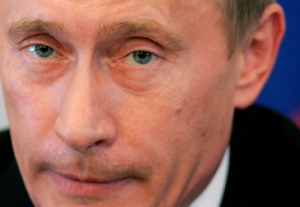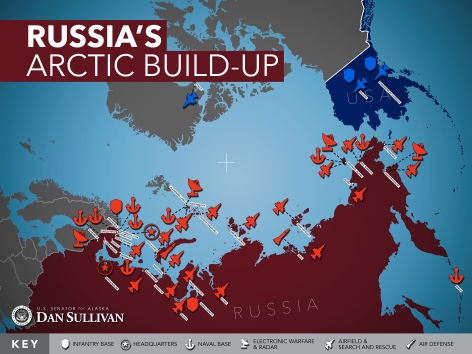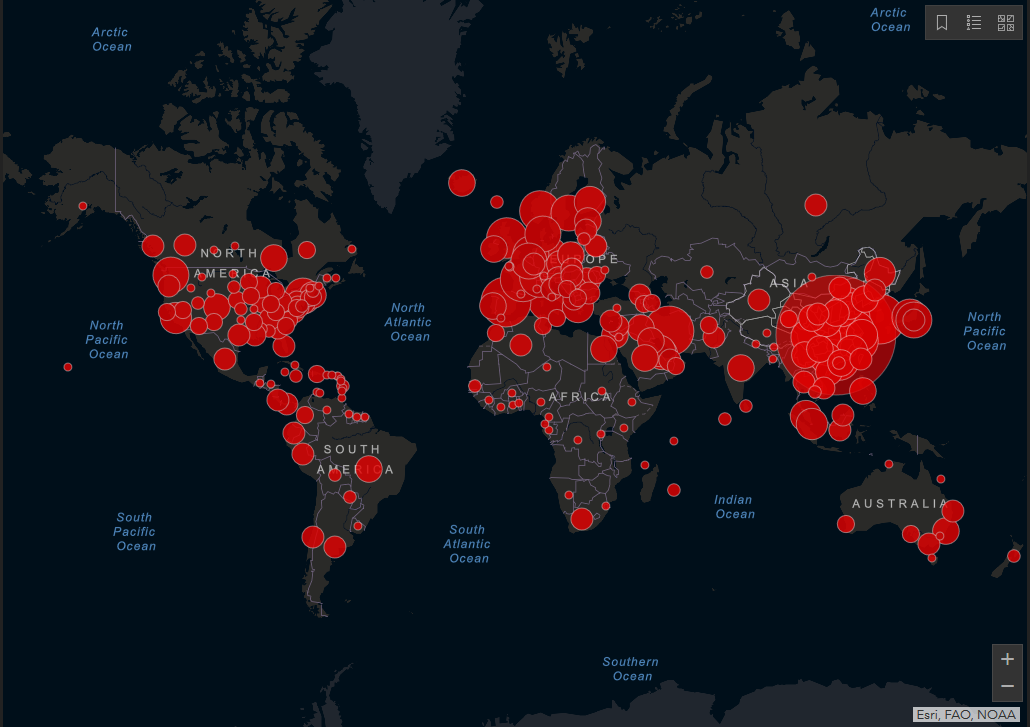Republic of PeruType of state: Republic with multiparty system featuring revived communist insurgency
Independence: July 28, 1821 (from Spain)
President of Peru: Alan Gabriel Ludwig García Pérez (American Popular Revolutionary Alliance): July 28, 1985-July 28, 1990, July 28, 2006-present
Political composition of national legislature: In the last election for Peru’s Congress of the Republic, which occurred on April 9, 2006, the seats were distributed in the following manner: Union for Peru (centrist, pro-Ollanta Humala) 45, American Popular Revolutionary Alliance (social democratic) 36, National Unity (Christian democratic) 17, Alliance for the Future (center-right, merger of Change 90 and New Majority, pro-Alberto Fujimori) 13, Center Front (merger of Popular Action (conservative liberal), We Are Peru, and National Coordination of Independents) 5, Peru Possible (centrist) 2, and National Restoration (evangelical Christian) 2.
Next general elections: Peru’s next general elections are scheduled for 2011.
Setting the record straight: In view of the communist revolution unfolding in Peru in the 1980s and early 1990s, and the failure of Alan Garcia during his first presidential administration to suppress that insurgency, we believe that President Alberto Fujimori was justified in utilizing the armed forces and National Intelligence Service to extirpate Shining Path. The rigorous application of anti-terrorism laws was essential to terminate the genocide that was then being perpetrated by the Maoists against the civilian population.
Communist government:
1) Revolutionary Government of the Armed Forces under the leadership of leftist, pro-Soviet/Castro General Juan Francisco Velasco Alvarado: 1968-1975 (deposed in coup by General Bermúdez)
2) Presidency of José Luis Bustamante y Rivero with support of the National Democratic Front, American Popular Revolutionary Alliance, and Peruvian Communist Party (Unity): 1945-1948
Communist insurgency:
1) Communist Party of Peru (Shining Path) (PCP(SL)): Founded in 1970 this genocidal political-military organization associates with the Revolutionary Internationalist Movement, which includes the Revolutionary Communist Party USA and Communist Party of Nepal (Maoist). In the Spanish the PCP(SL) is known as the Sendero Luminoso and its members Senderistas. Shining Path launched an infamously brutal “people’s war” in 1980. The party’s popular name originates from Peruvian socialist José Carlos Mariátegui, who proclaimed: “El Marxismo-Leninismo abrirá el sendero luminoso hacia la revolución” (“Marxism-Leninism will open the shining path to revolution”).
Shining Path traces its origins to the late 1960s when former university professor Abimael Guzmán (“Presidente Gonzalo”) formulated the organization’s ideology. The PCP(SL) defected from the Peruvian Communist Party (Red Flag), which in turn defected from the original Peruvian Communist Party (Unity), which in turn descended from the Peruvian Socialist Party, founded by Mariátegui in 1928. The Senderistas reduced their attacks after 1992, but in 2003 a remnant faction re-declared war against the government and people of Peru.
Shining Path first obtained a foothold in San Cristóbal of Huamanga University, where Maoist Guzmán taught philosophy. Many students adopted Shining Path’s radical ideology. Between 1973 and 1975 Shining Path gained control of the student councils in the Universities of Huancayo and La Cantuta, and developed a significant presence in the National University of Engineering in Lima and the National University of San Marcos. Sometime later, SL lost many student elections in the universities, including San Cristóbal of Huamanga, and decided to abandon the universities in order to repackage itself.
In the beginning of 1980, Shining Path formed a “Revolutionary Directorate” that was political and military in nature, and ordered its militias to transfer to strategic areas in the provinces to start the “armed struggle”. The group also held its “First Military School” where militants were instructed in military tactics and weapons use. Guzmán emerged from the First Military School as the clear leader of Shining Path.
Following the demise of the military regime that year, Shining Path was one of the few leftist groups that declined to take part in the first democratic elections in 12 years. Instead, SL opted to launch a guerrilla war in the highlands of the province of Ayacucho. On May 17, 1980, the eve of the presidential elections, it burned ballot boxes in the town of Chuschi, Ayacucho. It was the first “act of war” by Shining Path. Throughout the 1980s, Shining Path expanded its hold over Peruvian territory, particularly in the Andean highlands. The Maoist guerrillas killed cattle rustlers, managers of the state-controlled farming collectives and affluent merchants. Shining Path developed a devoted following of peasants in Ayacucho, Apurímac, and Huancavelica. However, ona small minority of peasants were ever as enthusiastically Maoist as the Shining Path cadre.
Shining Path’s credibility was also bolstered by the government’s initially tepid response to the insurgency. When it became evident that Shining Path represented a clear threat to the state, the government declared an “emergency zone” in the Ayacucho area, and granted the military the power to arbitrarily detain any suspicious person. Shining Path redirected its attention from the rural campaign to mounting urban attacks against the infrastructure in Lima. In 1983 SL sabotaged electrical transmission towers, causing a citywide blackout, torched the Bayer industrial plant, and bombed the offices of the governing party, Popular Action. Two years later, in June 1985, Shining Path again blew up electricity transmission towers in Lima, producing another blackout, and detonated car bombs near the government and justice palaces. According to some reports, Shining Path was also responsible for bombing a shopping Mall.
During this period Shining Path also assassinated leaders of other leftist groups, local political parties, labor unions, and peasant organizations, some of whom were anti-Sendero Marxists. In so doing the Maoist insurgents alienated much of Peru’s peasantry. The brutality of Shining Path’s “popular trials,” which included slitting throats, strangulation, stoning, and burning contributed to this alienation. Peasants organized anti-Shining Path patrols, called rondas, which launched their first attacks against Shining Path in 1983. Shining Path fought back without mercy. Wielding machetes and employing point-blank executions, the Maoist guerrillas slaughtered 67 civilians in the towns of Yanaccollpa, Ataccara, Llacchua, Muylacruz and Lucanamarca. Other incidents followed, such as the one in Hauyllo, Ayacucho Department, where Shining Path killed 47 peasants, including 14 children aged between four and fifteen. Additional massacres by Shining Path occurred, such as the one in Marcas on August 29, 1985.
In a 2006 article published in FrontPage Magazine, Theodore Dalrymple compared the bloodthirstiness of Shining Path with that of the genocidal Khmer Rouge regime in Cambodia. He wrote: “The worst brutality I ever saw was that committed by Sendero Luminoso (Shining Path) in Peru, in the days when it seemed possible that it might come to power. If it had, I think its massacres would have dwarfed those of the Khmer Rouge. As a doctor, I am accustomed to unpleasant sights, but nothing prepared me for what I saw in Ayacucho, where Sendero first developed under the sway of a professor of philosophy, Abimael Guzman.”
On April 24, 1985, in the midst of national elections, Shining Path attempted to assassinate Domingo García Rada, president of the Peruvian National Electoral Council. Rada was severely injured, while his driver was mortally wounded. In August 1991 Shining Path killed one Italian and two Polish priests in the department of Ancash and in February 1992 the group assassinated María Elena Moyano, a well-known community organizer in Villa El Salvador, a vast shantytown in Lima.
Shining Path also engaged in armed conflicts with Peru’s other major guerrilla group, the Túpac Amaru Revolutionary Movement (MRTA) and with the campesino self-defense groups organized by the Peruvian armed forces.
By 1991 Shining Path dominated much of the countryside in the center and south of Peru and exerted a powerfulpresence in the outskirts of Lima. A cult of personality now surrounded Guzmán. The official ideology of Shining Path was no longer Maoism, or “Marxism-Leninism-Mao Tse-tung thought,” but was referred to as “Marxism-Leninism-Maoism-Gonzalo thought.” In one of its last attacks in Lima, on July 16, 1992, Shining Path detonated a large bomb on Tarata Street in the upscale district of Miraflores in Lima. More than 20 people died and several buildings were leveled.
In 1991 President Alberto Fujimori declared the region of Ayacucho an emergency zone. Constitutional rights were suspended in the area. The president legalized the rondas, officially known as Committees of Self Defence (CAD), armed the peasant vigilante groups with 12-gauge shotguns, and ordered the Peruvian Army to train the committees. According to government statistics, 7,226 CADs existed in 2005. Four thousand of these groups are situated in Peru’s central region, Shining Path’s stronghold. The military’s response was normally heavy-handed against both insurgents and civilians, resulting in the portrayal of Shining Path as the lesser of two evils in the minds of some observers. The state also employed the National Intelligence Service against the Maoist insurgents, allegedly resulting in the La Cantuta massacre and the Barrios Altos massacre, both of which were committed by Grupo Colina.
On September 12, 1992 Peruvian police captured Guzmán and other Shining Path leaders in an apartment in the Surquillo district of Lima. From jail Guzmán called for peace talks, prompting the organization to splinter into several groups, some in support, others in opposition to a cessation of warfare. Óscar Ramírez assumed command of Shining Path upon Guzmán’s incarceration, but was himself apprehended in 1999. During its years of apparent disorganization during the 1990s, Shining Path has implemented only occasional guerrilla actions. However, the PCP’s ideology and tactics have influenced other Maoist insurgent groups associated with the Revolutionary Internationalist Movement. These groups include the Communist Party of Nepal (Maoist), which in 1996 launched its own war against the Nepalese monarchy and, after much bloodshed, was admitted into that country’s government in 2006. The US State Department lists Shining Path as a “Designated Foreign Terrorist Organization.”
A 2003 report released by the Truth and Reconciliation Commission, which was implemented by interim President Valentín Paniagua, 22,507 people perished in the insurgency, while 46,773 disappeared. The deaths of 31,331 people were officially attributed to Shining Path. The MRTA, by contrast, was reportedly responsible for 1.5% of the deaths.
Notwithstanding the attempt by the people of Peru to leave the Shining Path insurgency in the past, in 2003 a surviving faction of Shining Path called Proseguir (“Onward”) resurfaced, operating in three companies known as the North, the Centre, and the South. The government claims that Proseguir is operating in alliance with drug traffickers, which would identify Shining Path, like the Revolutionary Armed Forces of Colombia, as a component in the Communist Bloc’s narco-subversion strategy against the West. On June 9, 2003 Shining Path attacked a camp in Ayacucho, seizing 68 employees of the Argentinian natural gas company Techint, which was then building a pipeline between Cusco and Lima, and three police guards as hostages. According to Peru’s Interior Ministry, the terrorists demanded a ransom to release the hostages, but two days later a military operation forced Shining Path to abandon its hostages.
The Peruvian National Police has captured some members of the new generation of Shining Path commanders. In April 2000 government forces apprehended Commander José Arcela Chiroque (“Ormeño”), in July 2003 they apprehended Florentino Cerrón Cardozo (“Marcelo”), and in November of the same year they apprehended Jaime Zuñiga (“Cirilo” or “Dalton”). Officials insist that Zuñiga orchestrated the kidnapping of the Techint pipeline workers, as well as coordinated an ambush against an army helicopter in 1999 in which five soldiers died. In January 2004 a man identifying himself as Comrade Artemio and claiming to be a leader of Shining Path announced in a media interview that the Maoist organization would resume violent operations unless the Peruvian government amnestied other top Shining Path commanders within two months. Peru’s Interior Minister, Fernando Rospigliosi, promised that the government would respond “drastically and swiftly” to any violent action. In September of that same year Peruvian police arrested 17 suspected Senderistas, including, according to the Interior Minister, eight school teachers and two high-level school administrators.
Despite these arrests, on December 22, 2005 Shining Path ambushed a police patrol in the Huánuco region, killing eight. Later that day Senderistas wounded an additional two police officers. In response, then President Alejandro Toledo declared a state of emergency in Huánuco, granting to police the power to search houses and arrest suspects without warrant. On February 19, 2006 police killed Héctor Aponte, who was believed to be the commander responsible for the previous year’s ambush against their colleagues. In December 2006 Peruvian troops were deployed to counter revitalized guerrilla activity. According to high-level government officials, Shining Path presently boasts 300 combatants. The return of Alan García to the presidency of Peru, an office that he also held between 1985 and 1990 when he was unable to suppress the Senderistas, at the same time that many guerillas are now completing prison sentences has raised questions as to President García’s competence in eradicating the insurgents once and for all.
On October 13, 2006 Guzmán was re-sentenced to life in prison for terrorism. He is currently imprisoned in an underground cell at the San Lorenzo Island Naval Base, in Callao, the port of Lima. Fellow inmates include Victor Polay, leader of the Tupac Amaru Revolutionary Movement.
2) Túpac Amaru Revolutionary Movement (MRTA): The MRTA was a communist guerrilla army active in Peru from 1984 to 1997 and one of the main actors in the internal conflict in Peru. Founded in 1980 the MRTA represented a merger of the Revolutionary Socialist Party-Marxist Leninist (PSR-ML) and the Movement of the Revolutionary Left-The Militant (MIR-M). The PSR-ML consisted of ex-members of the Peruvian Armed Forces who belonged to the leftist military government of General Juan Francisco Velasco Alvarado (1968-1975), while the MIR-M represented a faction of the Movement of the Revolutionary Left, a Castroist guerrilla group that was otherwise crushed in 1965. The MRTA commander was Victor Polay Campos (“Comrade Rolando”) until his imprisonment and by Néstor Cerpa Cartolini (“Comrade Evaristo”) until his death in 1997. The MRTA’s namesake was Túpac Amaru II, an 18th-century rebel leader who was himself named after his ancestor Túpac Amaru, the last indigenous leader of the Inca people. At the apex of its strength, the MRTA boasted several hundred combatants who were committed to transforming Peru into a communist state and expelling all imperialist, meaning American, influences. The MRTA should be distinguished from the similarly named indigenous terrorist groups from Bolivia and Uruguay, the Tupac Katari Guerrilla Army and the Tupamaros National Liberation Movement, respectively.
The MRTA’s first operation occurred on May 3, 1982, when Central Committee members Polay and Jorge Talledo Feria and three other members robbed a bank in Lima. During the heist Talledo died by friendly fire and the movement’s first “martyr.” Peru’s counterinsurgency program, internal schisms, and clashes with Maoist rival Shining Path reduced the MRTA’s ability to execute terrorist attacks. On November 30, 1995 police arrested Lori Berenson, a former MIT student, FMLN sympathizer, and US socialist living in Lima. Berenson was accused of collaborating with the MRTA and sentenced by a military court to life imprisonment, later commuted to 20 years by a civilian court. Berenson’s case has become a cause célèbre for the International Left. The MRTA’s last major action occurred in December 1996, when 14 MRTA guerrillas occupied the Japanese Ambassador’s residence in Lima, holding 72 hostages for more than four months. Under orders from then-President Alberto Fujimori, the military stormed the residence in April 1997. All but one of the remaining hostages was rescued, while all MRTA militants were killed.
In 2003 the Peruvian government’s Truth and Reconciliation Commission noted the following distinctions between the tactics of the MRTA and Shining Path:
Unlike Shining Path, and like other armed Latin American organizations with which it maintained ties, the MRTA claimed responsibility for its actions, its members used uniforms or other identifiers to differentiate themselves from the civilian population, it abstained from attacking the unarmed population and at some points showed signs of being open to peace negotiations. Nevertheless, MRTA also engaged in criminal acts; it resorted to assassinations, such as in the case of General Enrique López Albújar, the taking of hostages and the systematic practice of kidnapping, all crimes that violate not only personal liberty but the international humanitarian law that the MRTA claimed to respect. It is important to highlight that MRTA also assassinated dissidents within its own ranks.
On March 22, 2006 a Peruvian court ruled that Polay was guilty of nearly 30 terrorism-related crimes committed during the late 1980s and early 1990s. Like Abimael Guzman, former leader of Shining Path, and Vladimiro Montesinos, Guzman’s nemesis and former director of the National Intelligence Service under President Fujimori, Polay is imprisoned at the Callao Naval Base.
3) 2000 Military Rebellion: In October 2000 Lieutenant Colonel Ollanta Moisés Humala Tasso (born 1963), who holds to a left-nationalist ideology, led a military rebellion of 60 soldiers in Toquepala (Tacna Region) against senior army commanders and then President Alberto Fujimori. The stated reason for the rebellion was Huamala’s opposition to the return of Vladimiro Montesinos, Fujimori’s chief of the National Intelligence Service who sought asylum in Panama after he was videotaped trying to bribe an opposition parliamentarian. During the mutiny 300 former soliders were reportedly preparing to join Humala, while the leftist newspaper La República lauded Humala for his “valiant” cause. By the end of the rebellion, however, many of the mutineers deserted Humala. Following the mutiny Humala and his co-conspirators hid until President Fujimori was impeached from office. Later Congress pardoned Humala and he was permitted to return to military duty.
Humala is the son of Isaac Humala, member of the Communist Party of Peru (Red Fatherland) and ideological leader of the Ethnocacerista movement. His brother is Antauro Humala, currently in prison for another failed uprising in 2005. Humala embraces Bolivarianism, the neo-communist ideology that President Hugo Chavez is implementing in Venezuela and which includes the concept of a pan-American socialist republic. During the 2006 presidential campaign Humala allegedly distanced himself from the radical left politics of his family. He ran on the centrist Union for Peru ticket, with the support of his own party, the Peruvian Nationalist Party. After obtaining a plurality in the first round, he lost the second round to Alan García.
Communist parties:
1) Christian Democratic Union (UDC): Founded in 1999 as a split from the Christian Democratic Party, the UDC is “left Christian” in orientation.
2) Communist Party of Peru (Marxist-Leninist) (PCdelP(M-L)): Founded in 1999 as a split from the Communist Party of Peru (Red Fatherland) this Maoist party associates with the ICMLPO(M).
3) Communist Party of Peru (Red Fatherland) (PCdelP(PR)): Founded in 1969 as a split from the Peruvian Communist Party (Red Flag), this ex-Maoist party associates with the Sao Paulo Forum and formerly associated with the ICMLPO(M).
4) Democratic Decentralist Party (PDD): Founded in 2002 this left socialist party operates under the leadership of Javier Diez Canseco.
5) Democratic Left (ID): ID operates under the leadership of Luis Zea.
6) Malpica Committee (CM): CM operates under the leadership of Raúl Wiener and Ricardo Letts.
7) Mariateguist United Party (PUM): Founded in 1984 this left socialist party associates with the Sao Paulo Forum.
8) Marxist Struggle (LM): Founded in 2000 this Trotskyist party associates with the LCMRCI and CCITP, and operates under the leadership of Sergio Bravo.
9) National Coordination of the Left (CNI): This alliance was founded in 2002.
10) National Front of Workers and Peasants (FNTC): Founded in 1968 this party is left indigenist in orientation.
11) New Decentralist Republic Party (PNRD): Founded in 2003 this party operates under the leadership of Manuel Dammert.
12) New Left Movement (MNI): This party was founded in 1998.
13) Party for the Social Democracy (PDS): Founded in 1997 this party operates under the leadership of Susana Villarán.
14) Peruvian Communist Party (Red Flag) (PCP(BR)): Founded in 1964 following a split in the original Peruvian Communist Party (Unity), PCP(BR) aligned itself with Maoism during the phoney Sino-Soviet split. Leaders included Saturnino Paredes, José Sotomayor and future Shining Path founder Abimael Guzmán.
15) Peruvian Communist Party (Unity) (PCP(U)): Founded in 1928 as the Peruvian Socialist Party the PCP(U) associates with the Sao Paulo Forum and formerly associated with the World Marxist Review and Communist International. The PCP(U) operates under the leadership of Julio Renán Raffo.
16) Popular Front (FP): Founded in 2003 this left socialist party operates under the leadership of Héctor Béjar Rivera.
17) Proletarian Party of Peru (PPP): This party associates with the International Communist Seminar and operates under the leadership of Illipa Tuta.
18) Revolutionary Socialist Party (PSR): Founded in 1976 this left socialist party associates with the Sao Paulo Forum and operates under the leadership of Víctor Oliva Miguel.
19) Revolutionary Workers’ Party (PRT): Founded in 1978 this Trotskyist party operates under the leadership of Raúl Castro Vera.
20) Roots Movement (MR): This radical left party was founded in 2002.
21) Socialist League (LS): This party is Trotskyist in orientation.
22) Socialist Left Force (FIS): This Trotskyist part associates with the IMT.
23) Socialist Party of Peru (PSP): Founded in 1930 as a split from the Communist Party of Peru, this left socialist party operates under the leadership of Luis Mateo Munoz.
24) Socialist Union (US): This radical left party operates under the leadership of Raul Wiener.
25) Socialist Workers’ Party (PST): Founded in 1982 this Trotskyist party associates with the LIT and operates under the leadership of Augusto Cárdenas.
26) Socialist Workers’ Party (PST): Founded in 1992 this Trotskyist party as a split from other PST, this party associates with the UIT and operates under the leadership of Enrique Fernández.
27) Socialist Workers’ Union (UOS): This party is radical left in orientation.
28) The Struggle Continues (LC): This party is Trotskyist in orientation.
29) Workers’ Party (PT): Founded in 1994 by the Revolutionary Marxist Workers’ Party (POMR) this Trotskyist party associates with the ILCWI.
30) Workers’ Power Peru (POP): This Trotskyist party was founded in 1986.
31) Workers’, Peasants’, Students’ and People’s Front (FOCEP): This radical left alliance was founded in 1977.
Communist Bloc memberships: United Nations, Latin American Parliament, Union of South American Nations (merger of Andean Community of Nations and Southern Common Market; to be implemented by December 2007)
Socialist International presence: American Popular Revolutionary Alliance
Sao Paulo Forum presence: Peruvian Communist Party (Unity), Socialist Party of Peru
Moscow-Beijing-Havana-Caracas Axis political/economic/military presence: The pro-communist social democratic regime in Lima is nurturing a growing economic and political relationship with Beijing. Putatively anti-communist President Alberto Fujimori, who decisively tackled Peru’s Maoist rebellion, visited China four times. The first visit took place in April 1991, the first state visit ever made by a Peruvian President to China. In October 1995 Chinese Premier Li Peng made an official visit to Peru, the first ever made by a Chinese Premier. On the Taiwan issue successive Peruvian governments have consistently supported Beijing’s One-China policy. In January 2005 Chinese Vice President Zeng Qinghong flew to Peru from Mexico at the invitation of Peruvian Vice President David Waisman Rjavinsthi. In Lima he met Peruvian President Alejandro Toledo Manrique, who indicated that the Peruvian government is satisfied with the progress of Peru-China relations. Zeng stated that the two countries would continue to cooperate in politics, economy, culture, science, tourism, and world affairs. Peru is the second leg of his five-nation visit to Latin America and the Caribbean, which will also take him to Venezuela, Trinidad and Tobago and Jamaica.
In February 2007 Peru and China entered negotiations to establish a free trade arrangement between the two states. The following month Li Changchun, pointman for the Communist Party of China (CPC) Central Committee, arrived in Lima to visit Peruvian President Alan Garcia. Peru boasts the largest overseas Chinese community in the region. China is Peru’s second largest trade partner, while bilateral trade volume reached US$3.9 billion in 2006. Peru has established more than 150 investment projects in China while China has invested several hundred million dollars in Peru’s mining, trade, and textile industries. Li also met with Mercedes Cabanillas, president of the Congress of Peru. He stated that the CPC wishes to form close relations with all friendly political parties in that country. Peru was the last stop on Li’s Latin America trip, which also included Mexico, Venezuela, Suriname, and Ecuador.
Since the leftist military government of General Juan Francisco Velasco Alvarado (1968-1975), Russia has supplied the Peruvian military itself with arms. The 2000 downfall of Peru’s former director of the National Intelligence Service (SIN) is connected to this well-established link between Moscow and Lima. Although named after Vladimir Lenin by his parents, who were devout communists, Vladimiro Montesinos apparently rejected his revolutionary upbringing as he moved up the ranks of the Peruvian military. In 1965, at the age of 20 years old, he studied at the US Army’s School of the Americas which has a reputation, deserved or not, of graduating Latin American military officers involved in various counterinsurgency operations throughout the Western Hemisphere. In 1976 Montesinos was sentenced for spying for the United States because he revealed a list of weapons that the leftist military regime in Peru bought from the Soviet Union. In February 1978 Montesinos was released after serving two years of prison. After Fujimori won the election on July 28, 1990, Montesinos became his chief advisor and the effective head of the SIN. Through this position he assumed widespread power in Peru. By promoting allies into top positions, moreover, Montesinos effectively obtained control of the Peruvian Armed Forces, which had discharged him for anti-Soviet activities years before. During the 1990s Montesinos frequently and secretly videotaped himself bribing individuals such as politicians, officials, military officers and probably President Fujimori himself.
In 2000 MSNBC reported that “rogue” figures in the Russian military and Federal Security Service, and the Red Mafiya were supplying arms to the Revolutionary Armed Forces of Colombia via Jordan and “corrupt” elements in the Peruvian armed forces. In response, Montesinos claimed that the SIN had uncovered the arms smuggling ring, but Jordan, whose own officials were implicated in the illegal operation, rejected the Peruvian version of the story. Instead, Amman insisted that the shipments were genuine government-to-government deals. Indeed, evidence related to the case indicated that Montesinos had orchestrated, rather than busted, the gun-running operation in collaboration with a senior Peruvian general and a government contractor who normally supplied the Peruvian military. The former director of Peruvian intelligence is currently imprisoned at the Callao Naval Base, along with his nemesis Abimael Guzman, former leader of Shining Path, and Victor Polay Campos, former leader of the Túpac Amaru Revolutionary Movement.
In a somewhat troubling development, in early 2007 Nicaragua’s Moscow-backed neo-Sandinista regime dispatched former Interior Minister Tomas Borge, Maoist, KGB stooge, and die-hard worshipper of Fidel Castro, to Peru as ambassador. While Borge’s presence in Peru is ostensibly related to the fact that he is married to a Peruvian woman, it might also be explicable in terms of a covert support role for Peru’s resurgent Shining Path movement.
















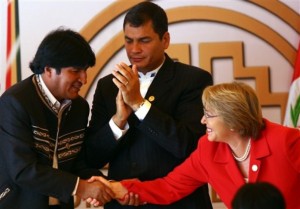










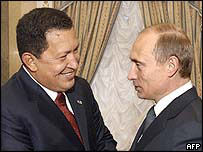














 The Leader referred to the rise of anti-US governments worldwide like the Islamic Republic of Iran as another sign of the collapse of unfair trend of the international relations.
The Leader referred to the rise of anti-US governments worldwide like the Islamic Republic of Iran as another sign of the collapse of unfair trend of the international relations.


 We’ve found in Russia a real strategic ally like in China and many other countries too. I remember the efforts by Vladimir before the coup of 2002 because they [the Russians] knew many things. He tried to prevent it but it was inevitable — the empire [USA] had already decided to overthrow the (Chavez) government.
We’ve found in Russia a real strategic ally like in China and many other countries too. I remember the efforts by Vladimir before the coup of 2002 because they [the Russians] knew many things. He tried to prevent it but it was inevitable — the empire [USA] had already decided to overthrow the (Chavez) government.








